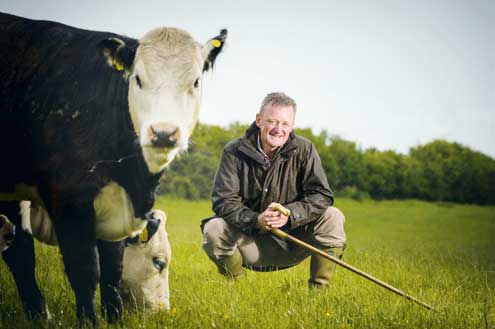Beef Farmer Award shortlist: Robert Parker

Ease of management, a focus on the maternal line and innovation link all of this year’s finalists for the 2012 Farmers WeeklyBeef Farmer of the Year Award. All of them have overhauled their businesses in recent years and proved that a focus on performance figures and costs can really benefit the bottom line
Robert Parker, Drumdow, Ervie, Stranraer
As an ambassador for native breeds, and specifically the attributes of the Black Baldie, Robert Parker stands apart. For him, the Aberdeen Angus x Hereford cow – commonly used elsewhere in the world – has allowed maximum use of farm resources with minimum labour input.
Traditionally Robert had sourced continental cross replacements from his brother’s neighbouring dairy farm. However as the herd introduced Holstein genetics to push for yields, he was becoming more disappointed with cow performance.
“On a farm with no cow housing and a large out-wintering area, I had to find an animal that would survive the weather in South West Scotland,” he explains. He bought his first Black Baldie in 1997 and hasn’t looked back since. “This cow was everything I needed – fertile, easy to manage and it meant I could breed my own replacements.” In fact he found the Black Baldie calves fattened 40 days earlier [than his previous herd? ASK ALY], saving nearly half a ton of feed.
| What the judges liked |
|---|
| • Simple, yet technical system • Profitable out-wintering system that suits his farm • Low input, easy-care cows and focus on maternal side |
To learn more about the attributes of this type of cow, Robert undertook a Nuffield Scholarship in 2006, after which he sold all his remaining continental bulls. “During my Nuffield days I visited producers who were taking advantage of the cow’s natural fleshing ability on limited feed. I learnt it wasn’t about big steers, but producing good, fertile cows.” Now all cows on an Angus passport are mated to Hereford, and vice versa. Cows and two-year-old heifers calve at grass over a 12-week period with 90% of the herd calving in the first six weeks.
The focus is on breeding heifers and cow numbers have increased by 40 over the past three years to capture this market. Heifers are sold off grass at 400-420kg at 13-14 months of age. They usually attract a number of repeat buyers at about £1,200 a head. All bulls are bought on maternal EBVs with emphasis on milk and daughter calving ease.
“Only heifers born in the first six weeks of the calving period are used as breeders. Those not in-calf within the 12-week bulling period are sold cast or prime – there is no autumn calving herd for unproductive cows,” he says.
Steers are taken through winter, housed on sawdust and sold through a store ring at 11 months at 380kg, averaging £825 a head. High health status is very important to Robert, with the herd vaccinated for BVD and leptospirosis and accredited Johne’s free. “BVD is the cow equivalent of AIDs to me – if you get rid of this you get rid of everything else,” he says.
| Farm facts |
|---|
| • 180 beef cows – predominantly Aberdeen Angus x Hereford (Black Baldies) • Focus on producing breeding heifers with stores sold at 11 months • Cows out-wintered on moorland |
Robert’s experience as a Scottish Monitor Farm in 2004 has also highlighted the importance of regular monitoring – something he has continued to the present day. “It’s really important to blood-test at least every two to three years to get an idea of where you are at,” he says. “I blood-test cows every year and this season it’s bought up an iodine deficiency which we will bolus for.” Soils are also regularly tested and monitored.
The Black Baldie is ideal for his farm set-up where cattle are out-wintered from November on 50ha of moorland, which is part of the Countryside Premium scheme. “I’m paid £35/acre not to graze the moorland in the summer. Technically my winter “shed” costs are making me money,” he says.
When it comes to pastures, Robert has focused on introducing as much clover as he can into swards which has allowed a 10t reduction in fertiliser use over three years. He also swears by the use of composted sawdust from his sheds, which he describes as “rocket fuel” for pastures. His grass management has been recognised a number of times, including winning the 2004 and 2005 Southwest Scotland Grassland Society beef silage competition.
Robert is involved in a number of industry organisations including, chairman of the local NFU. He also sits on the R&D committee that looks after the Monitor Farms Programme and is on the board for Quality Meat Scotland, which has been heavily involved in a project to improve beef eating quality.
A word from our sponsor
 McDonald’s buys beef from more than 16,000 British and Irish farmers each year and we’re committed to working with these farmers to ensure they have a successful and sustainable future. We are therefore proud to once again support the Farmers Weekly Beef Farmer of the Year Award.”
McDonald’s buys beef from more than 16,000 British and Irish farmers each year and we’re committed to working with these farmers to ensure they have a successful and sustainable future. We are therefore proud to once again support the Farmers Weekly Beef Farmer of the Year Award.”
Brian Mullens, senior vice-president
See more
Find out more about the 2012 Farmers Weekly Awards including details on how to books tables for the event’s glittering London awards bash
